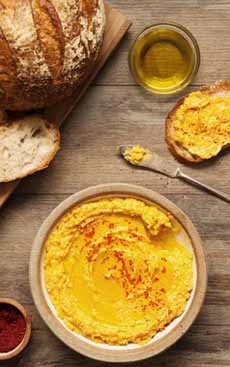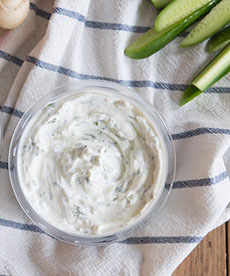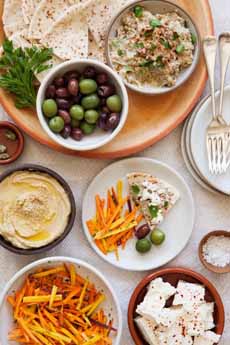FOOD FUN: Combine Two Popular Dips, Hummus & Tzatziki
 Hummiki: a blend of hummus and tzatziki (photo © Hannah Kaminsky | Bittersweet Blog).
|
Leave it to our creative colleague, Hannah Kaminsky, to come up with this one: combining two great Mediterranean spreads, hummus and tzatziki (tsat-ZEE-kee). Both of us love Mediterranean spreads, and we’ve included our dozen favorites below. But who would have thought to mix two of them together: hummus and tzatziki, chickpea paste and yogurt dip? She named the blend hummiki. “It exceeded even my own expectations from the very first batch. Lighter and fresher than the typical dip, crisp cucumbers added textural contrast so often missing from hummus. “Zesty lemon and dill brightened the flavor profile considerably, imparting an unmistakably summery flavor, even if made in the heart of winter.” The recipe follows, and today’s tip is: Don’t hesitate to mix and match. Our foray includes blending sour cream or yogurt into sauces to make creamy sauces or dips; but we’re going to put on our thinking cap to do more. Note that Hannah did not include tahini, the oily ground sesame paste that is the second ingredient in hummus. So, if you want a hack of mixing store-bought hummus and tzatziki, it will be different from this recipe. Ingredients For 3-1/2 To 4 Cups 1. TOSS all of the ingredients except for the cucumber, into a food processor or blender. Purée thoroughly, until silky-smooth. Scrape down the sides of the bowl as needed, and give the machine ample time to blend. For the best consistency, it may take as long as 5 – 10 minutes. When thoroughly blended, add salt and pepper to taste. 2. STIR in the chopped cucumber by hand, and chill for at least 2 hours before serving. It will keep in an airtight container in the fridge for up to a week…if you can resist finishing it long before then. Depending on country—Greece versus any of the countries in what was formerly called the Levant*—there may be different names for the same or similar dishes. For example, Greek tzatziki is Turkish cacik. Here are a dozen favorites. Note that spellings may differ because the names are transliterated into the Latin alphabet from the Arabic or Greek alphabets. Baba ghanoush: Smoky roasted eggplant and tahini combine in a dip that can be smooth or chunky. Baba ghannouj is another spelling. Here’s a recipe. Cacik: The Turkish name for tzatiki, a yogurt and cucumber dip. It is pronounced kah-SEEK. Ezme: Similar to Israeli salad, ezme is a Turkish salad of finely chopped tomatoes, cucumbers, onions, mild peppers, parsley and olive oil. Hummus: A paste of chickpeas, olive oil, garlic and spices. There surge in popularity has resulted in dozens of blend-ins, from the traditional Mediterranean flavors (olive, red pepper) to the trendy (chipotle, edamame hummus, everything bagel topping). Here’s a recipe to make your own. Labneh: Labneh is thick, strained yogurt with a consistency similar to spreadable cheese like cream cheese. It is spread onto pita. Here’d more about it, and a recipe. Htipiti: Htipiti (tee-PEE-tee) is a spicy spread of roasted red pepper and feta, mixed with olive oil, thyme, shallots and garlic. It can be smooth or chunky, and is closely related to kopanisti and tirokafteri (see below). Melitzanosalata: This traditional Greek Eggplant dip is difference from baba ghanoush in that the latter is Levantine* and uses tahini. Melitzanosalata is Greek and doesn’t have tahini. Common ingredients are eggplant, olive oil, garlic, lemon, salt, pepper. Some melitzanosalata recipes add onion. Chopped parsley is a traditional garnish. |
|
|
Mezze or meze: What we would call assorted appetizers, a selection of small dishes that originally accompanied drinks, either as a snack or as a first course to a meal. Mezze (MEH-zay) can include the dips and spreads on this list, served with pita; plus dolmades (stuffed grape leaves), falafel, feta, halloumi cheese, kibbeh, olives, etc. Check out this list. Muhammara: A Syrian dish of roasted red peppers, walnuts and pomegranate molasses. Skordalia: A Greek potato and garlic dip. Tabbouleh: A salad of bulgur, chopped parsley, mint, onion and tomatoes, seasoned with olive oil, lemon juice, salt and pepper. Taramosalata: A spread made from tarama, cured carp (or other fish) roe, whipped with lemon juice and olive oil. Tirokafteri: Feta cheese dip, similar to htipiti. It includes feta, olive oil, red wine vinegar, chopped chilies or red pepper flakes, oregano, and often roasted red peppers (not hot) and yogurt. Kopanisti, another spicy feta dip, includes olive oil, lemon juice, mint, pepperoncini, garlic and red pepper flakes. Tzatziki: A yogurt and cucumber dip. It is very similar to Indian raita, and like the latter, it is also served with grilled meats. Here are recipes for both. ________________ *The Levant was a large area in southwest Asia: south of the Taurus Mountains, with the Mediterranean Sea as the western boundary, and the north Arabian Desert and Mesopotamia in the east. “Levant” is an English term that first appeared in 1497. It originally referred to the “Mediterranean lands east of Italy.” The historical area comprises modern-day Iraq, Israel, Jordan, Lebanon, Palestine and Syria. Among other popular foods, Levantine cuisine gave birth to baklava, balafel, kebabs, mezze (including tabbouleh, hummus and baba ghanoush), pita and za’atar, among other dishes that are enjoyed in the U.S. and around the world.
|
||





